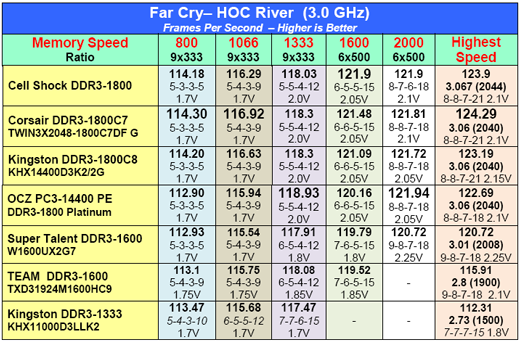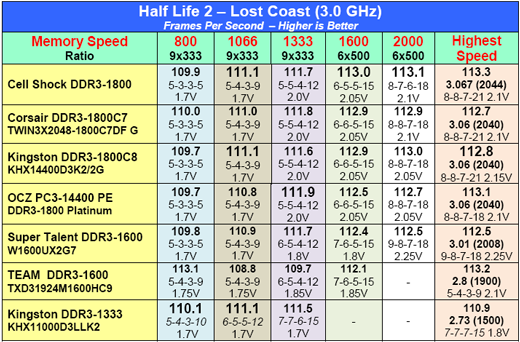Cell Shock, Corsair, and Kingston Introduce Ultra Speed DDR3
by Wesley Fink on October 11, 2007 10:00 PM EST- Posted in
- Memory
Gaming Performance
Three DX9 games representing different gaming engines are used to test the performance of the Kingston DDR3-1800C8, Corsair DDR3-1800 C7, and Cell Shock DDR3-1800 in real-world gaming. There are certainly more recent gaming titles available, but they are also DX9 and still similar in benchmarking demands as the games tested here. We will update games in the memory test suite as soon as a selection of DX10 games with reliable benchmarks is available. At that time the memory test OS will also be moved to Vista.
The Far Cry - River demo was run for 3 loops and results in FPS were averaged over the 3 runs.
Memories with Micron chips now top Far Cry performance at all memory speeds from DDR3-800 to DDR3-2000 and beyond.
Quake 4 and the underlying engine have always proved to be very sensitive to improvements in memory bandwidth. This is amply demonstrated in these memory tests. The performance increases in Quake 4 as DDR3 speed increases are the largest among the tested games.
Kingston, based on Elpida LL memory, performs best at the slower 800 and 1066 speeds, with OCZ and the other Z9 memory topping DDR-1333 to DDR3-2000+. With the constant CPU speed of 3.0GHz we see frame rates improve from 116 to 118 FPS at DDR3-800 5-3-3 to 130 FPS at DDR3-2000 8-8-7, an improvement of just over 12% among the DDR3 test group. We have commented many times that memory is just one small part of the performance equation, but a 12% improvement in a game frame rate merely as the result of an increase in memory speed is significant. Far Cry sees a similar increase from 112.90 at 800 to 124.3 at DDR3-2040, which is about a 10% improvement.
We include Half Life 2: Lost Coast as a representative of games that are less sensitive to improvements in memory bandwidth. Lost Coast is played through the Steam engine, where there is the constant worry, for a reviewer, that each new update of Steam will break your test benchmarks. Though the differences are very subtle and HL2 performance is most influenced by the video card used in the benchmark, there are nonetheless patterns that are exactly the same as the other two games.
The Kingston Elpida-based memory wins by a small margin at 800 and ties the Micron-based Cell Shock and Kingston DDR3-1800C8 at the DDR3-1066 speed. Other Micron based memories win the competitions at higher speeds with the Cell Shock the closest to standout performance. All of the results among the Z9 Micron kits are very close.
Some end users consider 7-7-7 timings at high DDR3 speeds a milestone with DDR3. We set those timings and pushed the each of the 3 DDR3-1800 kits as far as possible. The results are very interesting. The OCZ reached DDR3-1900 at 7-7-7 in an earlier review. The three new DDR3-1800 kits all outperformed this result, with Cell Shock reaching DDR3-1952, Kingston reaching DDR3-1960, and Corsair reaching the highest DDR3-1972 - all at 7-7-7- or 7-7-6 timings at 2.1 to 2.15V. We are very close to stable DDR3-2000 at 7-7-7 timings which will further improve DDR3 performance at the top of its speed range.
Three DX9 games representing different gaming engines are used to test the performance of the Kingston DDR3-1800C8, Corsair DDR3-1800 C7, and Cell Shock DDR3-1800 in real-world gaming. There are certainly more recent gaming titles available, but they are also DX9 and still similar in benchmarking demands as the games tested here. We will update games in the memory test suite as soon as a selection of DX10 games with reliable benchmarks is available. At that time the memory test OS will also be moved to Vista.
The Far Cry - River demo was run for 3 loops and results in FPS were averaged over the 3 runs.
 |
| Click chart to enlarge |
Memories with Micron chips now top Far Cry performance at all memory speeds from DDR3-800 to DDR3-2000 and beyond.
Quake 4 and the underlying engine have always proved to be very sensitive to improvements in memory bandwidth. This is amply demonstrated in these memory tests. The performance increases in Quake 4 as DDR3 speed increases are the largest among the tested games.
 |
| Click chart to enlarge |
Kingston, based on Elpida LL memory, performs best at the slower 800 and 1066 speeds, with OCZ and the other Z9 memory topping DDR-1333 to DDR3-2000+. With the constant CPU speed of 3.0GHz we see frame rates improve from 116 to 118 FPS at DDR3-800 5-3-3 to 130 FPS at DDR3-2000 8-8-7, an improvement of just over 12% among the DDR3 test group. We have commented many times that memory is just one small part of the performance equation, but a 12% improvement in a game frame rate merely as the result of an increase in memory speed is significant. Far Cry sees a similar increase from 112.90 at 800 to 124.3 at DDR3-2040, which is about a 10% improvement.
 |
| Click chart to enlarge |
We include Half Life 2: Lost Coast as a representative of games that are less sensitive to improvements in memory bandwidth. Lost Coast is played through the Steam engine, where there is the constant worry, for a reviewer, that each new update of Steam will break your test benchmarks. Though the differences are very subtle and HL2 performance is most influenced by the video card used in the benchmark, there are nonetheless patterns that are exactly the same as the other two games.
The Kingston Elpida-based memory wins by a small margin at 800 and ties the Micron-based Cell Shock and Kingston DDR3-1800C8 at the DDR3-1066 speed. Other Micron based memories win the competitions at higher speeds with the Cell Shock the closest to standout performance. All of the results among the Z9 Micron kits are very close.
Some end users consider 7-7-7 timings at high DDR3 speeds a milestone with DDR3. We set those timings and pushed the each of the 3 DDR3-1800 kits as far as possible. The results are very interesting. The OCZ reached DDR3-1900 at 7-7-7 in an earlier review. The three new DDR3-1800 kits all outperformed this result, with Cell Shock reaching DDR3-1952, Kingston reaching DDR3-1960, and Corsair reaching the highest DDR3-1972 - all at 7-7-7- or 7-7-6 timings at 2.1 to 2.15V. We are very close to stable DDR3-2000 at 7-7-7 timings which will further improve DDR3 performance at the top of its speed range.










12 Comments
View All Comments
geok1ng - Thursday, August 28, 2008 - link
looking at http://www.anandtech.com/mb/showdoc.aspx?i=3208&am...">http://www.anandtech.com/mb/showdoc.aspx?i=3208&am... one may wish that an E8600 can reach 10x400Mhz using 2:1 divider + tRD 5 + DDR3 1600 for top notch performance. I look forward for FSB 400/DDR3 1600 CAS 6 examples of memory performance.mandos9 - Tuesday, November 6, 2007 - link
"The recent performance improvements in DDR3 memory have far exceeded anything the end user or industry expected to see in such a short period of time. "The performance improvement is,in comparison to ddr2,5-7fps.That's almost nothing,especially when the games you test already run at 100+ fps(why don't you test it on the crysis demo or games that have come out more recently?).
I don't see why i should spend 600(or 300 for that matter) euro to upgrade my pc, when i can buy a second 8800GT for 250 euro and get 30 or more fps.
Nobody would buy ddr3 for performance. I can only see me buying it if i want a new mobo which i will not have to replace in a year or two.
nrb - Monday, October 15, 2007 - link
Oh joy, yet another anandtech article where I can't see any of the graphs. How many more years are you guys going to allow this to go on?(sigh)
Wesley Fink - Monday, October 15, 2007 - link
The charts are all there. We can read them fine in IE and Firefox. I just double-chescked to make sure there are no broken links. Can you please let us know what you are using as a browser?DrMrLordX - Saturday, October 13, 2007 - link
Why have you not included latency numbers as measured in cycles and/or nanoseconds?goinginstyle - Friday, October 12, 2007 - link
Do you think we could see a DDR2 memory review? Only about 90% of the desktop systems released in the last couple of years use it and considering the unbelievably low prices now it would be nice to see a review of memory that people actually use. It is getting boring to see $650~$900 memory reviewed when most of us cannot even begin to think about buying it or even can afford it if we wanted to change. Show us some results on memory that most people use now.Wesley Fink - Monday, October 15, 2007 - link
The Kingston DDR3, which performed at the top of our test results, has a MSRP of $450 for the 2GB kit - NOT 650-900. It is still much higher than DDR2 but prices are starting to come down.We do have a DDR2 roundup coming in the near future. However, if you look back at the DDR2 review you will find many of the currently available DDR2 memory has been reviewed at AT before the introduction of DDR3.
retrospooty - Friday, October 12, 2007 - link
at DDR 2000 at 6X500 CPU the best sisoft standard memory score for DDR3 is 9138 at DDR3 2000 8-7-6-18 ... I get 8871 with my DDR2 1000mhz at 4-4-4-10 with a similar setup on a DFI P35 mobo.Thats a lot of cash for an extra 267 mb per second bandwidth. Granted my memory setting are highly tuned, but the speed difference is even smaller than I had imagined. I would say the "dramatic" speed increases are totally crippled by the "dramatic" latency penalties. Hopefully in a year or 2 we will see some lower latencies.
Wesley Fink - Monday, October 15, 2007 - link
Congratulations on your great Buffered bandwidth scores with DDR2. We use a standardized setup and do not really tweak timings as you have. Any of our test results can ge tweaked to produce much higher test results, so it is best to compare apples to apples.At 1066 our DDR3 at 5-4-3-9 timings is an Sandra bandwidth of 6763, while you get 8871, a difference of 2100+. We are confident we could tweak the 1066 timings to pick up the 2100 points since the latest DDR-3 based on Z9 chips is testing equal or faster than the fastest DDR2 at the same speed at 1066 or above. That means DDR3-2000 could be 2300+ higher when tweaked for top bandwidth. In addition the fastest possible BIOS timings at 1066 with DDR3 are 5-3-3-5, and we are not far from that.
If you check some enthusiast postings where they tweak the DDR3 for bandwidth you will find bandwidths exceeding 11000 on Sandra with Z9 based dimms. I suspect you already know this.
Anonymous Freak - Thursday, October 11, 2007 - link
At the top of each page of the article is the list of places to buy:That's all well and good. But the last four are the same company. (Ritz Camera owns Wolf, Camera World, and PhotoAlley.)